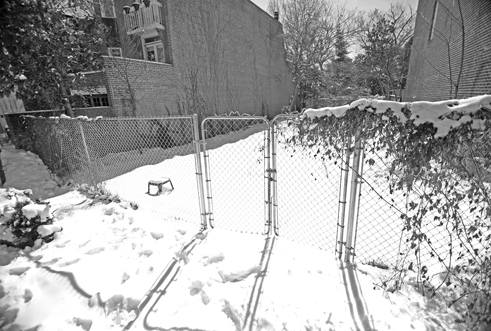Georgetown Pushes for Dent Place Archaeological Work

By Brady HoltCurrent Staff Writer
In the early 19th century, one of Georgetown’s prominent residents was Yarrow Mamout — a skilled brickmaker and businessman who had climbed the community’s social and economic ladder after arriving in the U.S. from Africa on a slave ship.
Yarrow lived in a log home at what is now 3324 Dent Place from 1796 to around 1832. In recent years, the property has been most famous for the blighted condition of the 1850s home there, which neighbors said attracted vermin and insects as it gradually decayed and was even partially crushed by a tree.
That house is now gone, the lot cleared in anticipation of redevelopment. But there’s a growing push in the community to keep the land empty, at the very least until an intensive archaeological excavation can take place — both to find artifacts specific to Yarrow and also as a statement that the neighborhood isn’t ignoring part of its heritage.
“It is necessary that some semblance of the fact that African-Americans once lived in Georgetown must remain,” said Vernon Ricks Jr., president of the board of trustees for the Mount Zion United Methodist Church at 1334 29th St. “This site should be preserved as a living museum of African-American history,” Ricks said, speaking at last Monday’s meeting of the Georgetown advisory neighborhood commission.
Commissioners voted unanimously March 2 to ask the city to block any building permits or ground disturbance at the property until its “very significant archaeological potential” can be fully explored. The city’s archaeologist conducted a brief examination last year but lacked the funding to undertake more elaborate digs using ground-penetrating radar.
The money for the effort thus would likely need to come from private sources — possibly including the property’s owner, who hopes to sell, and its prospective developer, who hopes to build one or two homes there. After all, if the city were to grant the commission’s request, these parties would be limited in what they could do with the property until the dig was complete. Ricks said the Mount Zion church will also contribute toward a study.
Neighborhood commission chair Ron Lewis wrote in an email to The Current after the meeting that he considers “an intensive archaeological investigation of the Dent Place land a realistic and important goal.”
Edward Giefer, spokesperson for the D.C. Office of Planning, which includes the city’s Historic Preservation Office, said the agency is planning for a grant-funded investigation this spring but funding details haven’t been finalized.
“If we discover artifacts or features that would justify the designation of the property as a historic landmark, then we would consider a nomination, but we first have to conduct an investigation to determine whether any significant resources remain,” he wrote in an email to The Current. “Only after we find out the results of the investigation will we determine what the appropriate next step is.”
James Johnston, author the 2012 book “From Slave Ship to Harvard: Yarrow Mamout and the History of an African American Family,” said at the commission meeting that artifacts are highly likely to remain buried at 3324 Dent Place.
Yarrow’s log cabin was destroyed in a fire at some point, and the most recent house on the site was built in the 1850s, but the cabin’s stone foundation and some of the original logs are likely still there, said Johnston. “If your house burned down, everything was left on the property,” he said. “They didn’t have trash collection in those days.”
Johnston also raised the slight possibility of finding items from West Africa that Yarrow could have brought with him on the slave ship. There has also been speculation that Yarrow was buried on the property.
One Georgetown resident, Bob vom Eigen, raised concerns at the meeting about the neighborhood commission’s request. He said he was impressed by Yarrow’s history but not the way the commission is proposing to handle it.
“I question about putting the burden on the owner of the site,” he said. “To condition a building permit on an owner doing an archaeological dig when the D.C. government says they can’t afford it, I can’t support it.”
Commissioners have expressed little sympathy for the property owner in the past, blaming her for allowing the historic home to deteriorate so badly that demolition was the only option. They’ve also opposed plans by the developer who intends to buy the site, urging preservation authorities to allow only a single modest home on the site rather than two larger ones.
But attendees at last week’s meeting focused mainly on the site’s historical value, rather than the logistics of excavation or preservation.
“There’s nothing else like it, and it would be lost if developed,” one woman said. She called for a reconstruction of Yarrow’s cabin, saying it “would give a glimpse of another early Georgetown that sadly vanished long ago.”
This article appears in the March 11 issue of The Georgetown Current newspaper.





